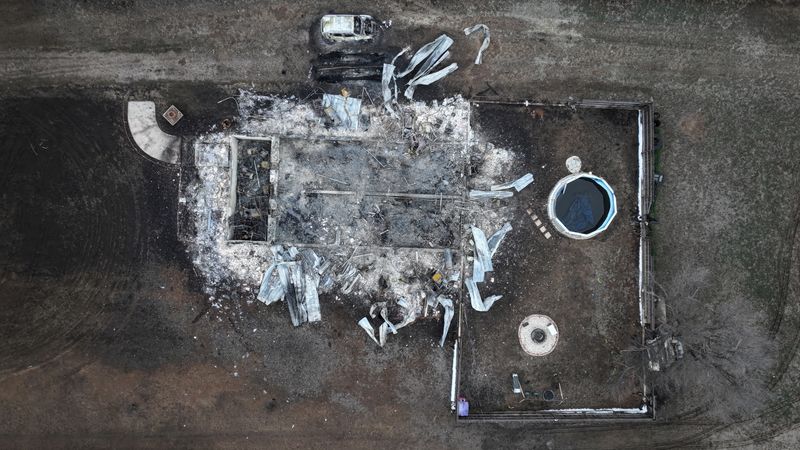© Reuters. A drone view shows a home destroyed by the Smokehouse Creek Fire, in Stinnett, Texas, United States, February 29, 2024. REUTERS/Nathan Frandino
2/5
By Leah Millis, Brendan O’Brien and Rich McKay
CANADIAN, Texas (Reuters) -Fire crews in the Texas Panhandle on Friday were dousing lingering hot spots after the state’s largest wildfire on record raced through the cattle-ranching region, aiming to prevent an expected bout of wind gusts from fanning the blaze again.
The deadly wildfire, dubbed the Smokehouse Creek Fire, has scorched more than 1 million acres (404,685 hectares), according to the latest figures from the Texas A&M Forest Service, provided on Thursday.
The blaze, which is centered on the rural town of Canadian, Texas, with a population 2,600, has spread eastward across the state’s border with Oklahoma, killed two people, torched dozens of homes and turned cattle-grazing land into ash.
Apocalyptic scenes of thousands of cattle corpses marred the once-fertile grasslands around Canadian on Friday, according to Wes Avent, who owns a local ranch supply store that he turned into a makeshift station for distributing donated feed, fencing and other supplies to ranchers.
“Right now our biggest chore is to get feed to the cattle that survived,” Avent said. “We’ve got to get feed and hay out to these guys as fast as we can.”
A miles-long line of tractor trailers snaked along the highway into Canadian on Friday, waiting to deliver bales of cattle feed and other supplies to desperate ranchers.
“Terrible is not strong enough of a word,” said Canadian’s mayor, Terrill Bartlett, 67, who owns a lumber company. “The ground is just black in all directions.”
While firefighters have gained a measure of control over the blaze, the danger has not passed, said Sean Dugan, a forest service spokesperson.
“We’re looking at the next few hot, dry days that will be windy,” Dugan said. “Those heavy fuels will come back alive with dry and windy weather, kicking up embers and …carry them over into unburned fuel.”
The agency was unable to provide up-to-date figures on the size of the area burned in the fire or the level of containment, which stood at 3% on Thursday.
Firefighters were attempting to survey the fire to gain a better understanding of the magnitude of the destruction, Dugan said.
The two people killed in the wildfire included a woman who succumbed to her injuries on Thursday, her family said on GoFundMe.com. She was rushed to a burn center in Oklahoma City after she was overcome with smoke and flames while driving her truck in Pampa, Texas, on Tuesday, local news reported.
An 83-year-old woman in Hutchinson County, northeast of Amarillo, was also killed in the fire, according to local media.
Scott Brewster, Canadian’s fire chief, said 109 homes were destroyed in the town and surrounding Hemphill County, as well as an unspecified number of barns or other structures.
“As far as cattle, I don’t think anyone knows yet,” he said. “I talked to one rancher and he said he lost 700 cattle. And that’s just one guy. There’s no telling what the tally will be, but it’ll be up there.”
Over the weekend, the weather forecast for the Texas Panhandle calls for no rain and winds of up to 45 miles (72 km) per hour, said Bob Oravec, a meteorologist with the National Weather Service’s Weather Prediction Center in College Park, Maryland.
“These are ingredients for more fire,” Oravec said. “The winds have no moisture content coming from the southwest. It dries out the stuff that burns.”
According to the latest Texas A&M Forest Service numbers, the Smokehouse Creek Fire has now burned through 1.08 million acres (437,060 hectares), or nearly 1,700 square miles, an area larger than New York’s Long Island. That replaced a 2006 fire that charred about 900,000 acres as the most expansive in state history.
Several smaller wildfires were burning in other parts of the Panhandle. The next largest, the Windy Deuce fire, has burned 142,000 acres and was 50% contained on Friday, according to Texas A&M.
